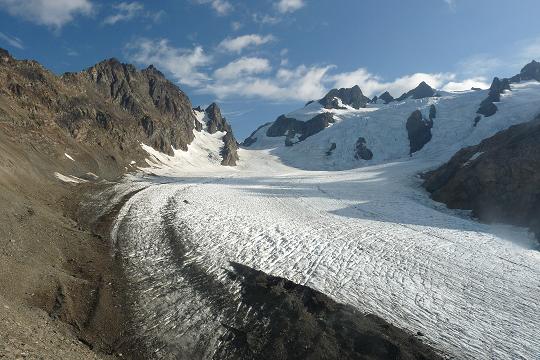
the Mount Olympus summit massif.

|
|
The Blue Glacier is crossed to access the Mount Olympus summit massif. |
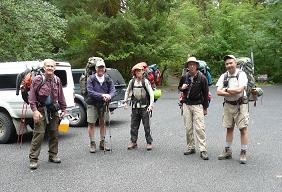
|
|
From reader's left - Don Nelsen, Dave Covill, Adam Helman, Richard Carey, Ken Russell. |
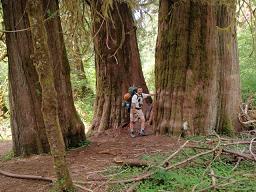
|
|
Ken amongst baby saplings. Imagine their size when fully grown! (Ken Russell photo) |
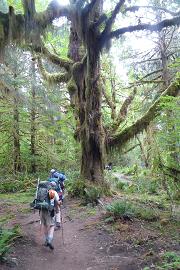
|
|
With all these mosses one guesses Costa Rica. |
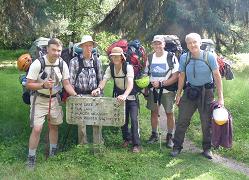
|
|
At the Guard Station roughly halfway to Glacier Meadows. From reader's right - see the first figure caption (a 1-in-120 chance) . |
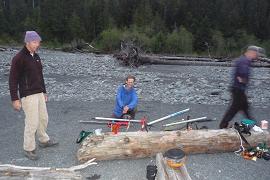
|
|
Having fun with ice axes at camp. The log is dead anyway, serving as a bench at mealtime. |
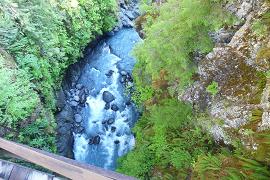
|
|
Hoh River hundreds of feet below the high bridge crossing. |
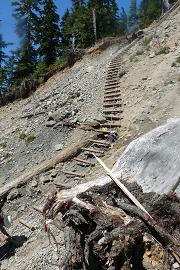
|
|
A rope ladder - what the Park Service can afford to accomodate climbers. |
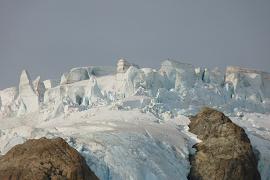
|
|
Ice fall and seracs feed the Blue Glacier. |
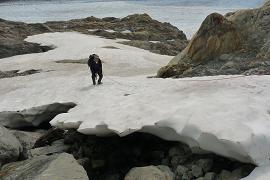
|
|
Dave and undercut snow as we near the Caltech Rocks. |
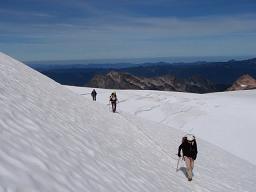
|
|
The second rope team with Richard (lead), Adam, and Don (rear). (Ken Russell photo) |
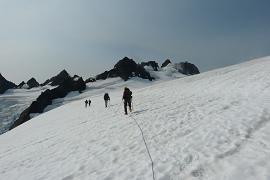
|
|
Traversing the Snow Dome with the summit massif in-sight. |
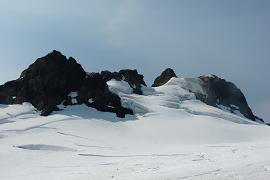
|
|
Summit massif. Our goal is slightly right of center. |
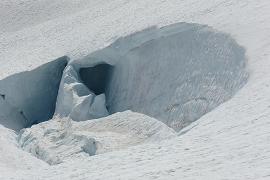
|
|
A Snow Dome "hole" at-once threatens and fascinates. |
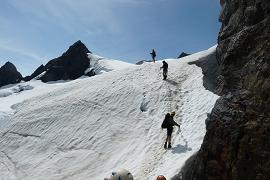
|
|
Just beyond Crystal Pass is this steeper section. |
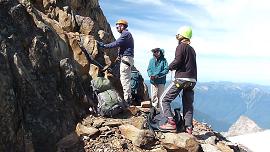
|
|
base of the summit rock pitch |
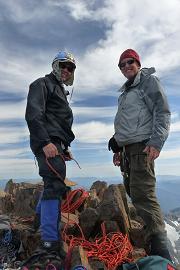
|
|
Dave (left) and Don at the summit. |
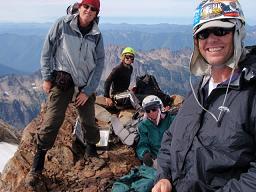
|
|
From left - Don, Adam, Richard, Dave (Ken Russell photo) |
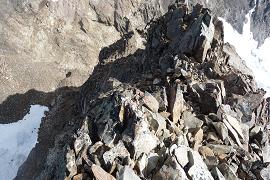
|
|
View down the rock pitch - we rappel this section. |
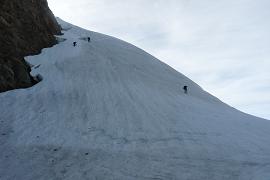
|
|
Descent of steep 50° snow abutting the summit rock. |
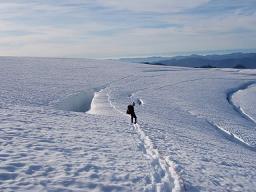
|
|
Dave is dwarfed by the Snow Dome. Parallel crevasses make travel "interesting". (Ken Russell photo) |
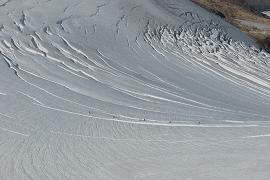
|
|
Mazamas group far below on the Snow Dome. Note the curvilinear crevasse field. |
The combination of sweat and general unwashedness is miserable. At the Hoh River bridge I steer clear of two girl hikers lest they get a whiff of me; stop at the trailhead side, and enjoy a snack of beef jerky and dried fruit.
At about mile 12 Don comes the opposite direction, having left his pack at the trail junction leading to our gravel bar camp at mile 10.5. He heads back to take weight from Richard, and I hike, in just over 30 minutes, to a long break as I wait for the others. It is strange: I believe that the plan was to reach the Guard Station at mile 9.1. Don says he is uncertain that Richard could make it that far today. I wait two hours at mile 10.5. I attempt to sleep, or at least rest on my ground pad - but the mosquitoes prevent any of this. I feel terrifically grungy and full of sweat. Everybody arrives, and we head for camp near the Guard Station. Evidently at some point Dave carried two packs - his own plus Richard's - providing him a sample of what it's like carrying over half your weight. WHAT FUN!! 8-( . I wash my entire torso in a nearby stream and change into a fresh shirt. Hey - I nearly feel normal. Richard crashes in his tent that I've already erected, getting macaroni and cheese for supper. Then I cook my own supper with chicken alfredo (yet no chicken). Dave has a treat for myself - instant tiramisu for the backcountry. It is wonderfully sweet. Dave also suggests that I remain behind with Richard on the final walk-out tomorrow. I balk because that means bearing weight for six hours when I can walk at my own pace and be over with it in just three. Besides, I already played this "waiting game" with Dan Baxter the other year! Shortly I realize that I can simply let Richard walk ahead of me after periodic rest stops; I then catch up with him after taking a longer break each time. With that realization I agree to holding-back with Richard. Besides, he is my friend, and so I know exactly what to talk about so as to better pass the time: previous climbs such as Organ Needle in New Mexico, our escapades at Animas Peak, Mount Jefferson of Oregon, and other venues. After a round of silly jokes (and Scottish accent imitation by Ken), that bottle of tequila is polished-off by making tang margaritas. We toast to "MOUNT OLYMPUS!" as I ritually clang drinking bottle with Richard's drinking mug through the tent entrance. We then toast to "BLOSSOM!", on Dave's suggestion, as it is by now well-known that it is my mother's birthday. Somehow I get a double portion, and I head for bed somewhat happy and satisfied. Wedneday, August 19 - Day 5 - Return and Celebration We arise about 7:30 a.m. and depart in short order, slightly more than an hour. Richard starts first, as previously, and I catch him after perhaps 15 minutes. It is well if he walks at 1.5 m.p.h. since then we'd get out at 1:30 p.m. with plenty of time to change, eat, and then reach our respective evening destinations. Richard's pace improves through the day; and, after Don runs back to retrieve his 20-25 pound pack, Richard walks at a sufficiently quick pace that I am truly comfortable with it given my pack weight. Don also takes about seven or eight pounds of Richard's gear from my pack, and I am revitalized by this "mass renormalization" (a term only physicists would appreciate).
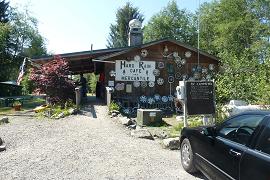
|
|
Our post-climb treats are enjoyed here. |
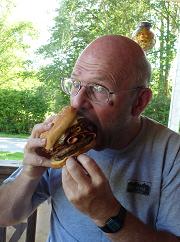
|
|
Dave commences to devour "BIGFOOT". |